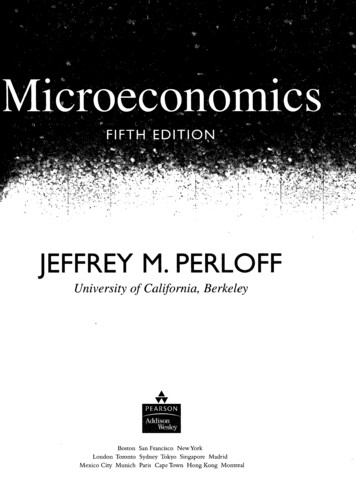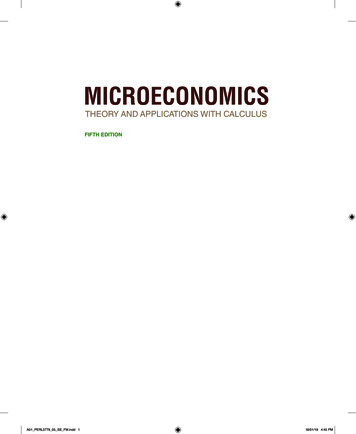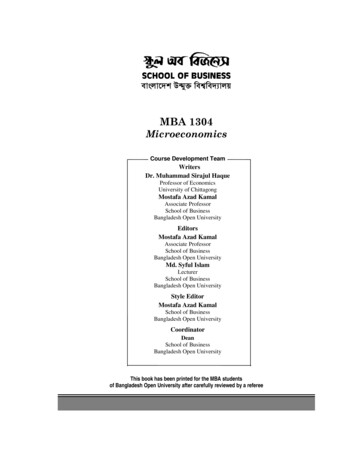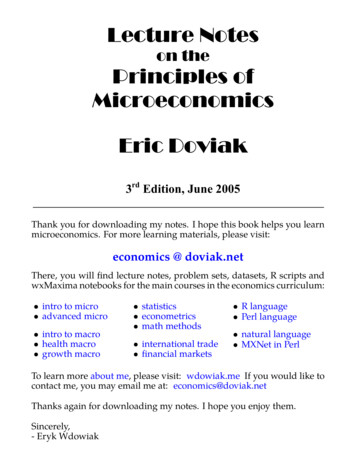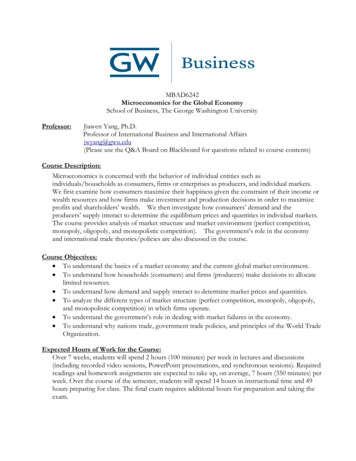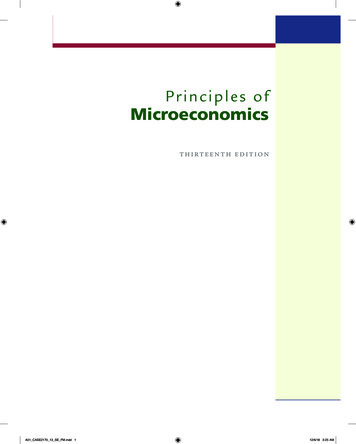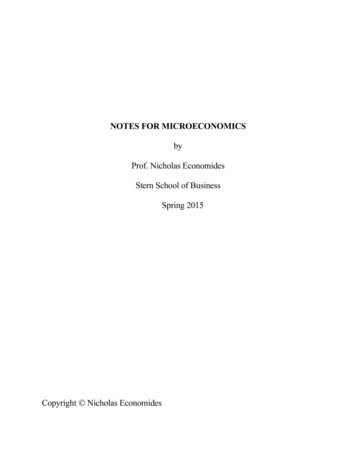
Transcription
NOTES FOR MICROECONOMICSbyProf. Nicholas EconomidesStern School of BusinessSpring 2015Copyright Nicholas Economides
MICROECONOMICS is about1. Buying decisions of the individual2. Buying and selling decisions of the firm3. The determination of prices and in markets4. The quantity, quality and variety of products5. Profits6. Consumers’ satisfactionThere are two sides in a market for a goodDEMANDSUPPLYCreated by ConsumersCreated by firmsEach consumer maximizesEach firm maximizes itssatisfaction --------------------------------- CONSUMPTION THEORY PRODUCTION THEORY1
We will first study consumption and later production. In the third part of thecourse we will take the “demand” schedule from the consumption analysis andthe “supply” schedule from the production analysis and put them together in amarket. The price, and the quantity exchanged will be determined in themarket. We will also discuss the performance and efficiency of markets.A.CONSUMPTION ANALYSIS UNDER CERTAINTY1. Goods are products or services that consumers or businesses desire.Examples: a book, a telephone call, insurance coverage. Goods may bedirectly desired by consumers or may contribute to the production of othergoods that are desired by consumers. For example a machine used in theproduction of cars is desirable because it is useful in the production of cars,although it has no direct value to a consumer. Bads are products or services thatconsumers desire less of. Examples: garbage, pollution, some telephone calls.Clearly, a good for one consumer could be a bad for another.2. If possible, each consumer would consume a very large (infinite) amount ofeach good. But, each individual is constrained by his/her ability to pay for thesegoods. The limitation of total funds available to an individual defines the2
budget constraint. Therefore a consumer has to maximize his/her satisfactionwhile not spending more than he/she has, i.e., without violating the budgetconstraint.3. We are interested to find the best choice for a consumer that has a limitedamount of funds. We accomplish this in three steps. At the first step, we definethe available choices taking into account the limitation of funds. At the secondstep, we discuss the desires/wants of the consumer. At the third step, we findthe optimal choice for the consumer by putting together the information wegathered in the previous two steps.STEP 1: We first analyze the available choices to a consumer that possesseslimited funds. Suppose there are only two goods, X and Y, and they are sold atprices px and py per unit respectively. If a consumer buys x units of good Xand y units of good Y, she spends xpx on good X, and ypy on good Y. Totalexpenditure isE xpx ypy.The pair (x, y) is called a (consumption) basket or (consumption) bundle.If the consumer has a total amount of money I (income) her total expenditurecannot exceed I, i.e.,3
xpx ypy I.This is called the budget constraint. The set of available (x, y) combinations iscalled the budget set. See Figure 1.Figure 1For example, X is apples sold at 1 per pound, Y is oranges sold at 0.5 each,and the consumer has I 3 to spend. Then the basket (1, 4) (i.e., 1 pound ofapples and 4 oranges) costs 1 4(.5) 3, and therefore is in the budget set.4
Note that since basket (1, 4) available to the consumer, so are baskets where shebuys less of each or less of both of the goods, such as (0, 4), (1, 3), (1, 2), etc.,since they cost less.4. The budget constraint can be represented in the X-Y space. There are twocases, either the consumer spends all her income and xpx ypy I, or theconsumer has some left-over income and xpx ypy I. We are primarilyinterested in the case where all income is spent. Note that and xpx ypy I is astraight line in the X-Y space. It is called the budget line. Its slope is -px/py. Ifthe consumer spends all the money in good X then she buys I/px units of thisgood. This is the maximum amount of X that she can buy. It defines the mostextreme point of the triangle on the X-axis. If all money is spend on good Y, itwill buy I/py units of good Y. This is the most extreme point of the triangle onthe y-axis.All bundles (x, y) where the consumer does not exhaust all income are belowthe budget line. The budget set contains all the points in the shaded triangle,including its boundary lines.STEP 2: We now describe the preferences of the consumers.5. In a comparison of any two bundles, A (xA, yA) and B (xB, yB), an5
individual should be able to say either(i)“I prefer A to B”; or(ii)“I prefer B to A”; or(iii) “I am indifferent between A and B”, i.e., “I like equally A and B”.This property of preferences is called completeness. Essentially the consumeris not allowed to say “I don’t know” or “I am not sure.”The second property of preferences is transitivity. If a person states, “I preferA to B,” as well as “I prefer B to C,” then he/she also has to prefer A to C. Thisassumption says that preferences are consistent, so that comparisons betweenbundles A and C are consistent with comparisons between bundles A and B andbetween B and C.Transitivity in indifference means that a person who says, “I am indifferentbetween A and B,” as well as “I am indifferent between B and C,” also has tobe indifferent between A and C.The third assumption on preferences is that “more is better”.6. Since “more is better”, if bundle A (xA, yA) has more of both goods thanbundle B (xB, yB), i.e., if xA xB and yA yB, then clearly a consumer willprefer A to B. Similarly if bundle A has less of both goods than bundle B, then6
a consumer will prefer B to A. However, if bundle A has more of X but less ofY than B, the comparison is not obvious. The consumer may prefer A to B, orprefer B to A, or be indifferent between A and B.One can create a collection of all the bundles, A, B, C, D, ., such that aparticular consumer is indifferent between any two of them. The line in X-Yspace that connects the points in this collection {A, B, C, D, .} is called anindifference curve, I1 (Figure 2). Of course, the same consumer typically hasmany indifference curves. For example, he has both A-B-C-D and E-F-G-H asindifference curves, and he prefers any bundle on E-F-G-H to any on A-B-C-D.In general, there is an indifference curve through any point in X-Y space.Since “more is better,” an indifference curve cannot have a positive slope.Indifference curves have a negative slope, and in special cases zero slope. Anindifference curve defines the substitution between goods X and Y that isacceptable in the mind of the consumer. As we move towards the Southeastalong a typical indifference curve the consumer receives more X and less Y,while she declares that she is equally well off.7
Figure 27. Typically indifference curves are convex. This means that starting with twobundles, A, B, which the consumer the consumer likes equally and are thereforeon the same indifference curve, she prefers C, the average of two extremebundles, rather than either of them. Bundle C has the average quantities ofbundles A and B in X and Y (Figure 3).8
Figure 38. Special cases of indifference curves. If the goods are perfect substitutes,the indifference curves have a constant slope, i.e., are straight lines. This meansthat the substitution between good X and good Y is constant, irrespective of thepoint on the indifference curve. Example, X is nickels, Y is dimes (Figure 4).If the goods are perfect complements, the consumer combines the goods in afixed proportion. Then, indifference curves are L-shaped. Examples: X is left9
shoes, Y is right shoes; X is personal computer CPUs, Y is video monitors(Figure 5).Figure 410
Figure 59. A consumer can be thought of as assigning a level of satisfaction (or utility)to each bundle, utility of bundle (x, y) is U(x, y). Then, all bundles on the sameindifference curve give the same level of satisfaction (utility). For example, inour earlier figure, the level of satisfaction of a consumer may be 2 at any pointon indifference curve EFGH, and the level of satisfaction may be 1 at any point11
on indifference curve ABCD.10. The marginal rate of substitution, is the rate at which a consumer iswilling to trade x for y. It is the slope of an indifference curve, MRS Δy/Δx.In general, the MRS varies along an indifference curve, that is, the MRS is ingeneral different when the starting bundle of a potential trade changes. Forperfect substitutes, the MRS is constant. Note that the marginal rate ofsubstitution (MRS) of consumer Z depends on individual preferences asexpressed by the indifference curves. It does not depend on the market or theprices that may prevail in the market.11. An additional unit of good X increases the level of satisfaction of aconsumer by the marginal utility of X, MUx. Similarly, an additional unit of Yincreases the level of satisfaction of a consumer by the marginal utility of Y,MUy. The marginal rate of substitution is equal to the ratio of the marginalutilities,MRS Δy/Δx - MUx/MUyWhy? In Figure 6, consider a move from bundle A to bundle B on the sameindifference curve. It can be broken into a vertical piece (change in Y) and ahorizontal piece (change in X) by defining bundle C.12
Figure 6MOVECHANGE IN UTILITYA to C(MUy)(Δy)C to B(MUx)(Δx) TOTAL, A to B(MUx)(Δx) (MUy)(Δy) 0Total change in utility between A and B is zero because A and B are on the13
same indifference curve. Rearranging the terms in this we derive the slope ofthe indifference curve,(MUy)(Δy) -(MUx)(Δx) MRS Δy/Δx - MUx/MUy.12. For a convex indifference curve, its slope goes from high on the left to lowon the right. This means that, as the consumer has more Y, she is willing togive up less and less in X in exchange for acquiring equal amounts of Y. Herindifference curves exhibit diminishing marginal rate of substitution.STEP 3: We now find the optimal choice of the consumer by combining theanalysis of her preferences with her available choices.13. Given convex and smooth indifference curves, the consumer maximizesutility at a point A, where the slope of the indifference curve (MRS) is equal tothe slope of the budget constraint. At the chosen point A we have tangency ofthe indifference curve and the budget constraint line (Figure 7),px/py MRS MUx/MUy, i.e., MUx/px MUy/py.This means that the consumer receives equal satisfaction for the last dollar spentin each good. The quantity of X that consumer Z chooses at A is called hisdemand for X. The demand of consumer Z varies as prices and incomechange. We denote it with x*(px, py, I). Similarly the demand of this consumer14
for good Y is y*(px, py, I).Figure 714. Tangency can fail at the optimal point(1) If the indifference curves are not smooth, for example if they have a kink,as in the case of perfect complements (Figure 8);(2) If the optimal point is at a corner of the budget set (Figure 9).15
Figure 816
Figure 915. Changes in income. As income expands the consumer changes his levelsof consumption. If more of X is consumed, then X is a normal good (Figure10). Example: high quality clothes. If less of X is consumed, then X is aninferior good (Figure 11). Example: low quality food, subway tokens. Theconsumption bundles A, B, C, as income increases are on the incomeexpansion path.17
Figure 1018
Figure 1116. Changes in prices. As the price of X decreases, there is a natural tendencyto consume more of the good that became cheaper. But, at the same time,because of the price decrease, the consumer suddenly finds herself morewealthy. She can buy the old bundle, and still have left-over money. We canseparate these two effects on the consumption of X as the substitution effect19
and the income effect. There is a natural tendency to buy more of the cheapergood. This is measured, roughly speaking, by the substitution effect. Theextra money left-over unspent after the price decrease may be spent on X or onY. The increase or decrease in the consumption of X resulting from theFigure 12spending of the left-over money is measured, roughly speaking, by the income20
effect. Note that a consumer may not like good X as much when she is richer,and could decrease its consumption as her income increases.17. Consider a price decrease that makes the consumer move from A to B. Webreak it into the change from A to C (substitution effect) and the change from Cto B (income effect). We isolate the substitution effect by taking away from theconsumer enough money to put her at the same level of satisfaction as beforethe price change. In Figure 12, the line through C has the same slope as the onethrough B, and is tangent to the indifference curve through A.18. The direction of the substitution effect is always opposite to the pricechange. If the good is normal, the income effect is in the same direction. Thetwo effects reinforce each other. Therefore, if a good is normal, the demandcurve (that shows how much would be sold at different prices) as slopesdownward. This is called the law of demand. A typical demand curve isshown in Figure 12a. This far we have used the notation x for quantity and pxfor price. For most of the remaining of the course we will use the notation Qfor quantity and P for price. Notice that there are two alternative ways tointerpret what a demand curve shows. First, the demand curve shows howmany units people are willing to buy at any particular price: Q(P). Second the21
demand curve shows what price would be fetched if a certain number of unitsof output were offered at the market: P(Q).Figure 12a19. If the good is inferior, the income effect goes in the opposite direction ofthe substitution effect (Figure 13). Typically, even for inferior goods, thedemand slopes downward, because the income effect is smaller than thesubstitution effect. If the good is very strongly inferior (in very rare cases), the22
income effect could be bigger than the substitution effect, so that the total effectis opposite to the substitution effect, and the demand slopes upward. Then thegood is called a Giffen good.Figure 1320. Specific taxes and taxes on wealth (Figure 14). The income-substitutionanalysis can be applied to taxation. Consider two alternative taxation schemes.23
In the first, only good X (say gasoline) is taxed, so that its price goes from px topx t, where t is the tax per gallon. In the second wealth, I, is taxed. Supposethat both schemes raise the same amount of total tax. Then the second schemeleaves consumers better off (i.e., on a higher indifference curve).Figure 1421. Elasticities measure the responsiveness of quantities traded to prices or24
income. Price elasticity measures the percentage change in quantity as aresponse to a percentage change in price. The (own) price elasticity ofdemand ise (ΔQ/Q)/(Δp/p) (ΔQ/Δp)(p/q).Note that e 0, and that the elasticity is not the slope of the demand curve. Forexample, for a linear demand curve Q a – bP, the slope is ΔQ/Δp -b(constant) but the elasticity of demand is –bp/q which varies as the quantity (orprice) changes.If e -1, i.e., e 1, the demand is elastic, i.e., highly responsive to changesin price. Typical for non-necessities, goods you do not have to buy, luxuries.If e -1, i.e., e 1, the demand is inelastic, i.e., not responsive to changes inprice. Typical for necessities, goods that you have to buy.If e -1, i.e., e 1, the demand is called uni-elastic.Generally, a demand is more elastic if the product has close substitutes.Demand for an individual brand is more elastic than market demand. Typically,elasticity of long run demand is higher than elasticity of short run demandbecause of wider availability of substitutes.22. The income elasticity of demand measures the responsiveness of the25
quantity demanded on income changes.eI (ΔQ/Q)/(ΔI/I) (ΔQ/ΔI)(I/Q).If eI 0, the good is normal. If eI 0, the good is inferior. Most goods arenormal. However, goods you buy when you have low income may be inferior.23. The cross elasticity of demand measures the responsiveness of thedemand for good X on price changes of another good, Y.ex,py (Δx/x)/(Δpy/py).If ex,py 0, x and y are substitutes (say Diet Coke and Diet Pepsi). If ex,py 0, xand y are complements (say computers and printers).24. If all units are sold at the same price, the consumers who are willing to buyat a high price benefit from the existence of consumers who are willing to payonly a low price. All units are sold at a price equal to the willingness to pay forthe last unit. The difference between what a consumer is willing to pay andwhat he actually pays is called consumers surplus.26
Figure 1525. The total willingness to pay up to Q units is the area under the demand upto Q units, A(Q). The actual expenditure is E(Q) QP(Q). The difference isconsumers’ surplus,CS(Q) A(Q) - E(Q).In Figure 15, expenditure E(Q) is double-shaded, and consumers' surplus CS(Q)is single-shaded. A(Q), the total willingness covers both shaded areas.27
B.CONSUMPTION ANALYSIS UNDER UNCERTAINTY26. Risk and Uncertainty.Example 1: Consider the choice between receiving 10 with certainty andreceiving 8 or 12 with probability 1/2 each. Note that both alternatives havethe same expected value of 10. The utility of the first alternative is U(10), andthe utility of the second alternative is U(8)/2 U(12)/2. Remember, bothalternatives have the same expected monetary value of 10, but only the firstone guarantees this amount with certainty. A risk-averse person will prefer thefirst (riskless) alternative. This means that for a risk averse person,U(10) U(8)/2 U(12)/2.Note that, for a risk-averse person, the utility of wealth is concave. See Figure16. This means that the marginal utility of wealth (the utility of the last dollar)is decreasing with wealth.28
Figure 16A risk-lover will prefer the second (risky) alternative, i.e., for himU(10) U(8)/2 U(12)/2.Note that, for a risk-lover, the utility of wealth is convex. See Figure 17. Thismeans that the marginal utility of wealth (the utility of the last dollar) isincreasing with wealth.29
Figure 17A risk-neutral person is indifferent between the two alternatives,U(10) U(8)/2 U(12)/2.For a risk-neutral person, the utility of wealth is a straight line. This means thatthe marginal utility of wealth (the utility of the last dollar) is constant for anylevel of wealth.We define the certainty-equivalent of an uncertain situation as the amount of30
money x that, if received with certainty, is considered equally desirable as theuncertain situation, i.e.,U(x) U(8)/2 U(12)/2.For a risk-averse person the certainty equivalent must be less than 10, x 10.For a risk-neutral person x 10, and for a risk-lover x 10.Example 2: Suppose that a consumer has utility functionU(W) W W1/2,where W is her wealth. First check that the consumer is risk averse (either byshowing that W is concave or by showing that he prefers 10 rather than the 8 or 12 lottery above). Suppose that this consumer with probability 1/200 ( 5/1000) has 10,000, and with probability 99/200 ( 995/1000) has 1,000,000.How much will she be willing to accept with certainty in return for thisuncertain situation?Solution: Facing the uncertain situation, her utility is.995* 1,000,000 .005* 10,000 .995*1,000 .005*100 995 0.5 995.5The certainty-equivalent is x such that x 995.5, i.e., x (995.5)2 991,020.25. The consumer is willing to accept 991,020.25 with certainty inreturn for her uncertain situation. Note that because the consumer is risk averse31
(equivalently because W is concave) the certainty-equivalent x 991,020.25is smaller than the expected dollar value of the uncertain situation which is.995*1,000,000 .005*10,000 995,000 50 995,050.27. Insurance. Suppose that a consumer has wealth WG with probability probG(if no “bad” event occurs), but his wealth is diminished to WB with probabilityprobB (if the “bad” event occurs). Since these are the only two eventualities,probG probB 1 must be true. The bad event creates a loss of L WG - WB.In general, an insurance company is willing to take away an uncertain situationand give in return to the consumer the same amount of money in both the“good” and “bad” eventualities. To be able to guarantee the same wealth evenif the bad event happens, the insurance company collects a fee, called thepremium. Thus, the insurance contract takes away from the consumer theuncertain world {WG with probability probG, WB with probability probB} andreplaces it with a certainty world {W, W}. The remaining question is how doesW relate to WG and WB. To start with, it must be that W is between the highand low wealth WG W WB (why?), but we need to find more specificallywhat W is acceptable to the consumer.Example 3: A consumer with utility function U(W) W has wealth from two32
sources. He has 10,000 in cash, and a house worth 990,000. Suppose thatthe house burns down completely with probability 0.005 (that is 0.5% or 5 in athousand). The house lot is assumed to be of no value. How much is theconsumer willing to pay for full insurance coverage?Notice that the consumer has wealth 1,000,000 with probability 0.995, and 10,000 with probability 0.005, so her uncertain situation is exactly as inexample 2. We have found above that the certainty equivalent of this uncertainsituation for this consumer is 991,020.25. Therefore she is willing to acceptany insurance contract that would leave her with wealth of at least 991,020.25(hopefully higher). The insurance contract that is just acceptable is the one thatleaves her with exactly 991,020.25. In insurance terms, this is a contract withcoverage of 990,000 and premium Pmax. To find the maximum premium theconsumer is willing to pay, Pmax, we reason as follows. If the house does notburn down, the consumer has wealth of 991,020.25 1,000,000 (originalwealth) – Pmax (premium). If the house burns down, the consumer has againwealth 991,020.25 10,000 (cash) 990,000 (payment from the insurancecompany) – Pmax (premium). Therefore the maximum premium acceptable tothe consumer is Pmax 1,000,000 - 991,020.25 8,979.75.33
Of course, the consumer is willing to accept full coverage of 990,000 for alower premium than Pmax. One such premium is the one that corresponds to anactuarially fair insurance contract that guarantees with certainty the dollarexpected value of the wealth of the uncertain situation it replaces. (In example 1this expected value is 10.) In example 2, the expected value of the wealth ofthe uncertain situation is (as we have calculated above).995*1,000,000 .005*10,000 995,000 50 995,050.Therefore the actuarially fair premium is Pact.fair 1,000,000 - 995,050 4,950. If the insurance company is risk neutral, charging the actuarially fairpremium allows the company to just break even. Any additional premiumabove the actuarially fair is profit to the risk neutral insurance company.Therefore the insurance company can have a profit of up to Pmax - Pact.fair 8979.75 - 4,950 4029.75. In summary, a risk neutral insurance companywill not charge a premium below 4,950 and the consumer will not accept apremium above 8,979.75. The premium will be between these two numbersand will depend on competition among insurance companies.C.PRODUCTION AND COSTS28. Output Q is produced from many inputs including labor man-hours L,34
capital (machine hours) K, land use, and other factors. For the purposes of thiscourse, we will assume a single variable factor of production, labor L. Therelationship between labor and output is summarized by the production functionQ f(L). We define the marginal productivity of labor as MPL df/dL. Wealso expect that marginal productivity MPL to be decreasing at high usagelevels of the particular input (L). See Figure 18. We also define the averageproductivityAPL Q/L f(L)/L.Since marginal productivity eventually (i.e., with high use of the input)decreases, it will eventually drive the average productivity down too.29. The cost of production of Q units is the cost wL of the input L required toproduce quantity Q f(L), where w is the price of labor. For example if Q f(L) 10L, then the amount L required to produce Q units is Q/10, andtherefore the cost to produce Q is C(Q) wQ/10. Similarly, if Q f(L) 10 L,the amount L required to produce Q units is (Q/10)2 and therefore the cost toproduce Q is C(Q) w(Q/10)2.35
Figure 1836
30. Returns to scale. A production function exhibits constant returns toscale (CRS) if doubling the input results in double output,f(2L) 2f(L).A production function exhibits increasing returns to scale (IRS) if doublingthe input results in more than double output,f(2L) 2fL).A production function exhibits decreasing returns to scale (DRS) if doublingthe inputs results in less than double output,f(2L) 2f(L).31. Total, fixed, variable, average, and marginal costs. Fixed or setup costsdo not vary with the level of production.Total costs:C(q) or TC(q).Variable costs:V(q).Fixed costs:F, constant.Breakdown of total costsC(q) F V(q).Average total cost:ATC(q) C(q)/q.Average variable cost:AVC(q) V(q)/q.Average fixed cost:AFC(q) F/q.37
ATC(q) F/q AVC(q).Incremental (marginal) cost: MC(q) C'(q) dC/dq V'(q) dV/dq.Incremental or marginal cost is the cost of production of an extra unit of q.Since extra production does not affect fixed cost, the increase in the total cost isthe same as the increase in the variable cost, MC(q) dC/dq dV/dq.32. We will examine three types of cost functions. The first type of costfunctions exhibits constant returns to scale. Every unit of output costs the sameto produce. Marginal cost is equal to average cost, AC(q) MC(q). See Figure19. Goods with constant returns to scale are typically hand-made where thesame amount of labor needs to be put in for every unit.33. The second type of cost functions exhibits increasing returns to scale forevery level of production. Marginal cost is the same for every unit, but there isan additional fixed or setup cost. See Figure 20. Many manufactured goodsrequire a fixed cost for the creation of a design and thereafter the incrementalcosts are constant. Examples: software, microchips.34. The third type of cost functions exhibits increasing returns to scale forsmall production levels and decreasing returns to scale for large productionlevels. See Figure 21. Example: traditional manufacturing.38
Figure 19Figure 2039
Figure 2135. Profit maximization. Profits, Π(q), generated by production level q aredefined as revenues, R(q), minus costs, C(q),Π(q) R(q) - C(q).In the simplest case, revenues are price times quantity R(q) pq.40
Figure 2341
36. Typically, profits are negative for small q because of positive setup coststhat cannot be recovered at low sales. Profits increase in q, reach a maximum,and then decrease. See Figure 23. In this course, we will assume that the firmtries to maximize profits. At the quantity level q* that maximizes profits, theslope of Π(q), dΠ/dq (incremental or marginal profit), is zero. At any q,dΠ/dq R'(q) - C'(q) MR(q) - MC(q).that is, incremental profit is always equal to incremental revenue minusincremental cost. Therefore, at q* that maximizes profits, marginal revenue isequal to marginal cost,dΠ/dq 0 i.e., MR(q*) MC(q*).This condition is necessary for profit maximization irrespective of theorganization of the industry and of the nature of competition. As we will seebelow, the nature and extent of competition in a market changes MR but usuallyhas no significant influence on MC.D.MARKET STRUCTURE37. By definition, in perfect competition, no firm has any influence on themarket price. Therefore, each unit of output is sold at the same price, p.Therefore, for a competitive firm, MR(q) p. Each firm perceives a horizontal42
demand for its output (at price p).38. A competitive firm chooses q* so thatp MR MC(q*).See Figure 24. If the price falls below minimum average total cost, the firmcloses down. Therefore the supply function of a competitive firm in the longrun is its marginal cost curve above minimum ATC.Figure 24For prices below minimum ATC, the firm supplies nothing, q 0. In the short43
run, a firm cannot recover its fixed costs (by closing down). Therefore therelevant cost function in the short run is average variable cost, AVC. The firm’ssupply function in the short run is MC above minimum AVC. In the short run, itsupplies zero if p min AVC. This means that there is a range of marketprices, between min ATC and min AVC, such that the firm willproduce a positive quantity in the short run, but will shut down in the long run.Profits are the shaded box in Figure 24,Π(q*) R(q*) - C(q*) q*[p - AC(q*)].Figure 25 shows the market supply with free entry of firms.44
Figure 2545
Figure 2639. Producers surplus is the difference between the revenue of the firm and itsvariable costs,PS(q) R(q) - V(q).Variable costs, V(q) can be represented by the area under the marginal costcurve (Figure 26). V(q) is the minimum revenue a firm is willing to accept in46
the short run to produce q.Total surplus (Figure 27) is the sum of consumers and producers surplus,TS(q) CS(q) PS(q).Since consumers surplus is the area under the demand minus revenue,CS(q) A(q) - R(q),total surplus isTS(q) A(q) - R(q) R(q) - V(q) A(q) - V(q).It is maximized at the quantity qc where the marginal cost curve intersects thedemand curve.47
Figure 2748
Figure 2840. If the market is not perfectly competitive, each firm faces a downwardsloping demand. Since revenue isR(q) qp(q),marginal revenue isMR(q) p q(dp/dq) p[1 (q/p)(dp/dq)] p
MICROECONOMICS is about 1. Buying decisions of the individual 2. Buying and selling decisions of the firm 3. The determination of prices and in markets 4. The quantity, quality and variety of products 5. Profits 6. Consumers’ satisfaction There are two sides in a market for a

